How to create a social media calendar that works
Written by Sarah Aboulhosn
Published on May 6, 2020
•Reading time 8 minutes

With the constant flow of new content, news and ideas, it’s easy to get caught up in the day-to-day of managing multiple social media accounts. Some brands like Wendy’s and Merriam-Webster are known for their quick wit and ability to jump on the latest trending topics.
Live tweets for major events or reactive posts related to significant news are engaging for your audience and interesting to create as a social team. But you don’t want to lose sight of the bigger picture, which means planning out and sticking to a well thought out social media calendar centered on the content you know your audience wants to see.
Ponder
Cogitate
RatiocinationIncredible thoughts, incredible minds: https://t.co/mx9TMQL30Z
— Merriam-Webster (@MerriamWebster) August 15, 2019
A social media calendar, like our Sprout social calendar, will save you time and allow you to track and test different strategies to see what resonates most with your audience. As a social media manager, planning out a social calendar months in advance and scheduling posts ahead of time will save you from scouring trending topics and news stories every day looking for ideas. It will also build greater consistency in terms of your brand voice and style than posting in a reactive or unplanned way.
This article will break down the basics of how to organize your content in a social media calendar so you always know what to post. Additionally, we’ll give you some strategies on ways to manage your schedule internally and how to promote collaboration across teams and departments.
Deciding what to post
If you’re new to social media marketing, one of the biggest roadblocks to creating a social media content calendar is knowing what to post. It might seem overwhelming to come up with enough ideas to fill an entire calendar, months ahead of time. But having a long-term social media plan will help you set realistic goals and make the process of creating a content calendar more manageable.
There are a few strategies that ensure you never run out of things to talk about on social media. Don’t rely on exciting things happening within your community or company to dictate what you post and when. There will be slow times and it’s important to have a plan to stay active on social media throughout those times.
To get this process rolling, conduct a social media audit of things you’ve posted in the past that received high engagement from your audience. To do this, you’ll need to pull together all of your unique social media analytics from sources such as Twitter or Facebook Insights. If you’re using Sprout Social, you can find metrics across multiple social networks in one place in Sprout’s Report Builder.

If you’re just getting started with a social strategy or don’t have old posts to refer to, do an audit of a competitor in your industry. Search for hashtags or keywords in your industry and identify the accounts with the highest engagement.

Once you have a few basic topics in mind, it helps to use a more in-depth research tool like social media listening to learn more about what your audience wants to see. By using listening for competitive research, you’ll see a comprehensive view of the hashtags, keywords, brands and topics that audiences like yours are engaging with on different social platforms. You can use this information to craft posts that are highly relevant to your audience and expand your reach to other people who may be interested in your content.

Social media is all about appealing to the people who follow your brand and providing them with value. That means testing different strategies and types of content to see what your audience likes best.
Organize your content with Sprout’s tagging features
Keep track of different campaigns, content styles and audience segments with tagging in Sprout.
You can filter Inbox messages, assign permissions and even compare performance of tagged groups in Sprout’s analytics
To get a look at how tagging can improve your efficiency and help you hone in on your top content, start a free Sprout Social trial today.
If you don’t have enough data to accurately gauge what your audience likes, create different types of content to see what your audience engages with most. Use a combination of promotional material, entertaining content and curated or user-generated content.
Promotional content tends to be sales-focused and can help you market your product.
#SproutTip: use Calendar Notes to highlight new opportunities, tap into resonating holidays or local events and support key company or client initiatives. https://t.co/hQrGQkoxTi pic.twitter.com/qVD7DF08ZN
— Sprout Social (@SproutSocial) August 13, 2019
Some content should serve the purpose to entertain your audience. It doesn’t have to relate to specifically to your product, but should still be relevant to your industry. It can include a fun, behind-the-scenes look at your brand.
Finally, it’s a good idea to supplement your own brand’s content with curated posts related to your niche or industry. These posts might be ones that mention your brand or a reshare of articles that have a unique view that your audience would enjoy.

Overall, make sure that the majority of the content you work into your social media calendar is intended to help your audience. While the exact mix will vary depending on your brand, niche and what types of content you see your audience respond to the most strongly, an initial rule of thumb to follow is making ⅔ of the content informational and ⅓ or less should be promotional. A constant stream of overly promotional social media posts can alienate followers, making it essential to emphasize engagement over sales in your social media calendar.
Creating your social media calendar posting schedule
Once you have an idea of the types of content you’re going to post, it’s time to create a posting schedule. After auditing your past posts or competitors’ posts, you will begin to notice trends. Take a look at what days and times they were posted and on which platforms. Make a note of any specific themes around the post. That information will help you organize and plan your posts to get the most visibility.
There’s a lot of competing information on how often you should post on social media. Some professionals recommend posting as regularly as possible to stay top of mind. Others suggest only posting if you have high quality and valuable information to add to the conversation.
Here are suggestions based on the most up-to-date research on how often to post to each social media platform for maximum visibility:
- Facebook pages: 1-2 per day
- Twitter: 3-10 times per day
- Instagram: 1-3 times per day
- Instagram Stories: 2-5 times per day
- Pinterest: 3-20 times per day
- LinkedIn: 1-2 times per week
There are also best practices around the best times to post on each platform, broken down by specific industries and niches.
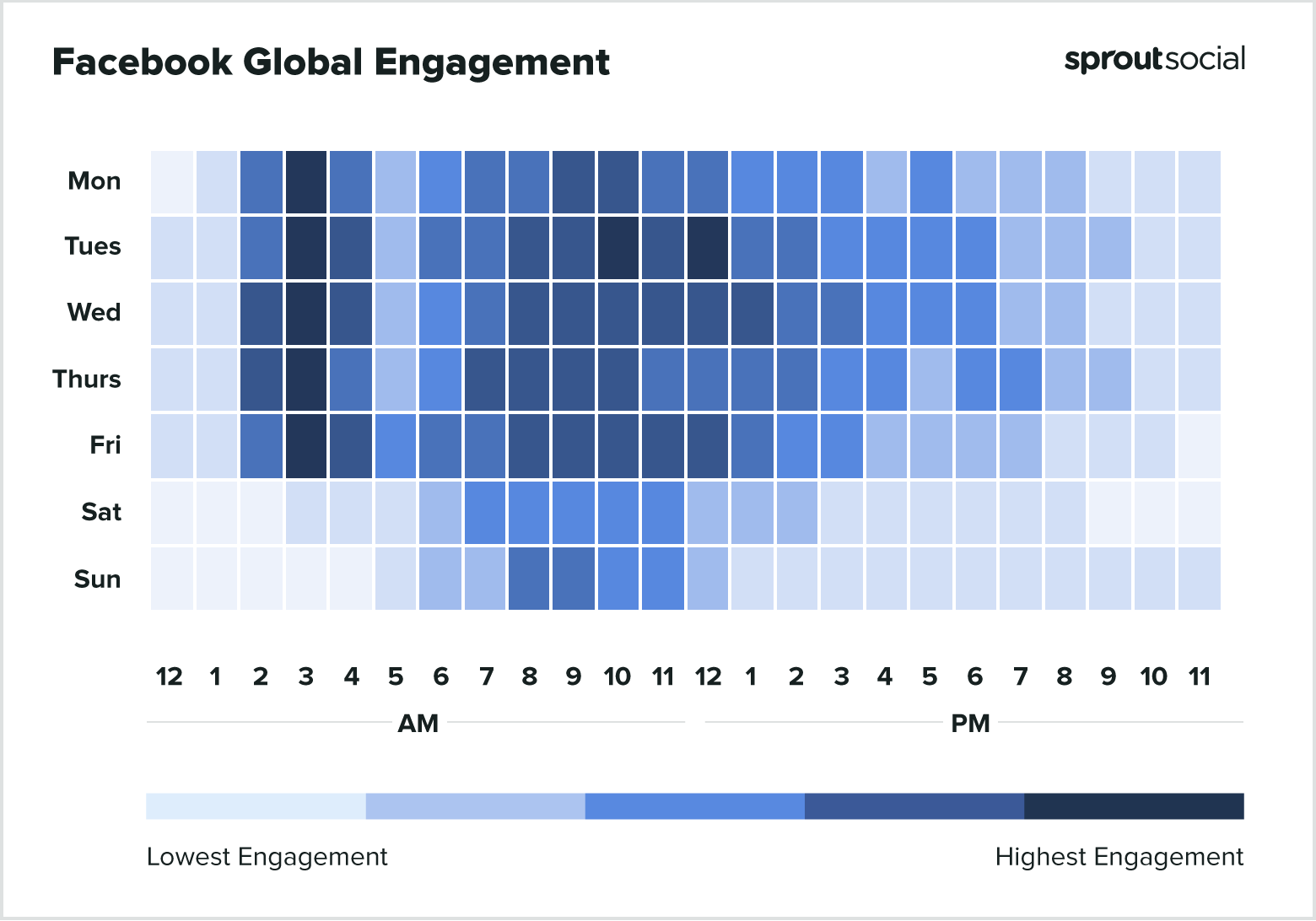
Posting frequently is one way to try to stay in front of your audience, but don’t emphasize quantity over quality. Be wary of sharing content that is irrelevant or redundant just to meet an artificial posting quota.
Using a tool like Sprout’s ViralPost™ feature helps you target posting times based on your individual audience data. ViralPost reviews this data and suggests Optimal Send Times for each platform you use.
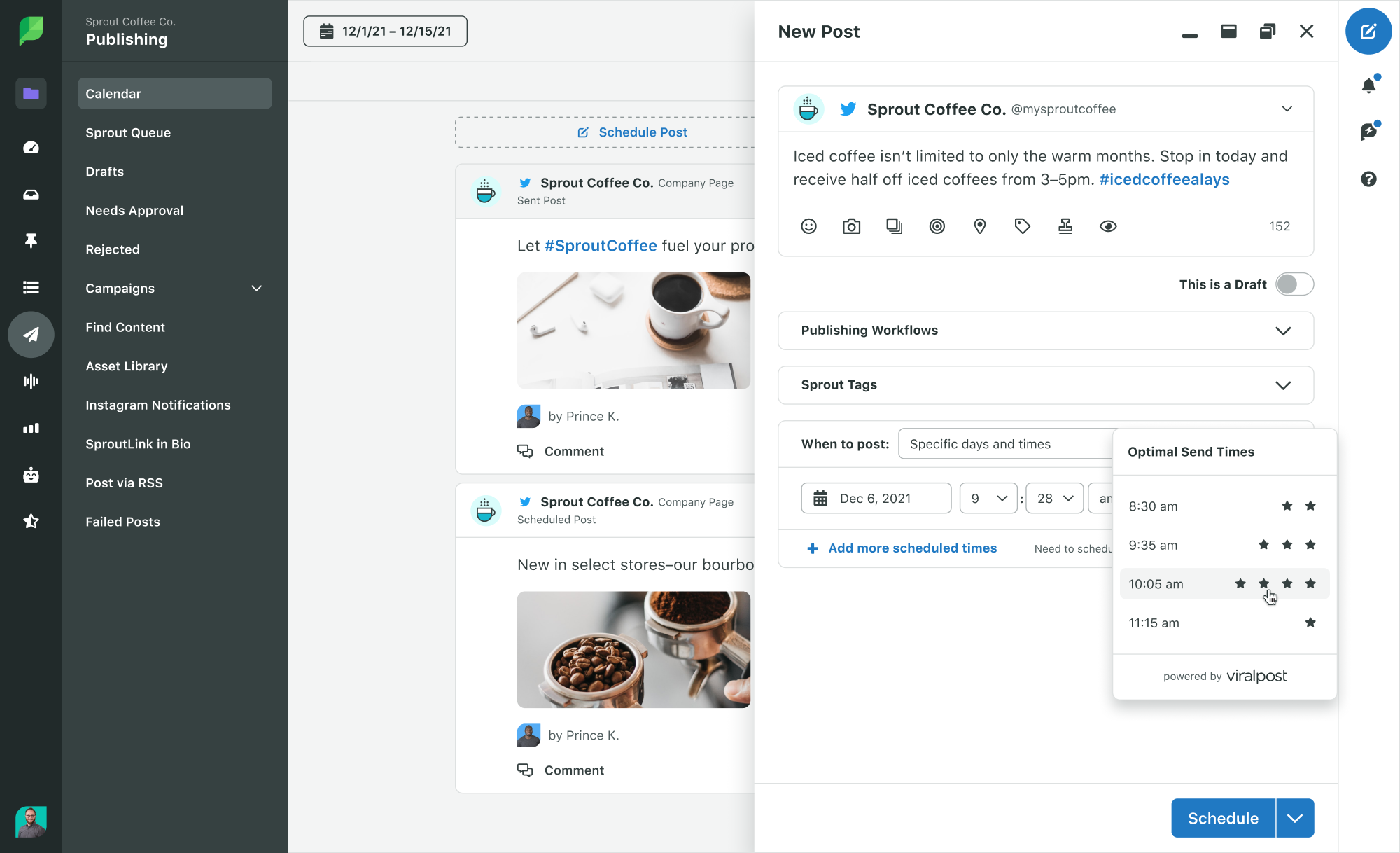
Every audience is unique, which is why you also want to conduct analysis and get an understanding of your audience as you continue to curate your social media content calendar. Take a look at your calendar and your analytics to find trends and patterns in the data. Noticing trends will help you see how people on different platforms react to different types of content and different posting times.
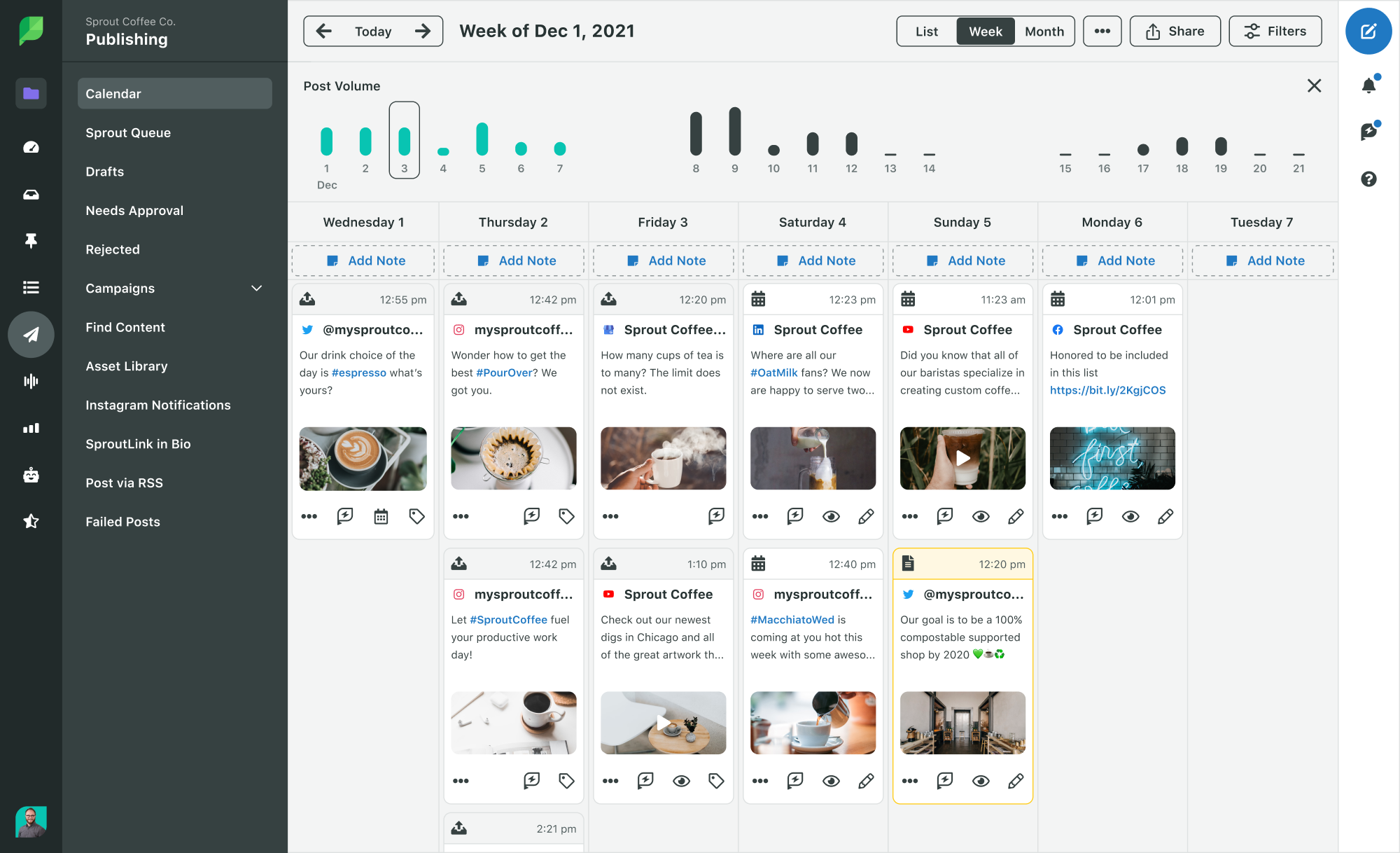
Creating a posting schedule that works is a process of constant experimentation and refinement. In the end, this pays off not only with a social media content calendar that delivers results, but also by helping you continually gain a better understanding of what your audience is seeking. As you continue to fill in your social media calendar, play around with different posting times and the number of times per week you post. It will give you a lot of insight into what works specifically for your audience.
Get the edge in social content scheduling
Read these guides to learn more about the best times to post and how to effectively use tools to build an efficient publishing process:
- The best times to post on social media
- 8 Top social media scheduling tools to save time
- 6 Simple steps to schedule Instagram posts
Tracking and analyzing your social media content calendar
Don’t look at your social media calendar as just a planning tool. It’s a way to track and measure campaigns across every platform you use. Analyze the information you collect from your social media campaigns and continue to optimize your social media calendar in the future.
When content performs well, don’t be afraid to save it or make a note to reintroduce it again in the future. Sprout’s Asset Library lets your store videos, text and images into an easy-to-access library that you can later re-incorporate into your social media strategy. Storing everything in a pre-approved library also helps ensure that all your images and multimedia assets are on point in terms of quality and brand style guidelines.

Account for specific campaigns across different social platforms. Different social media platforms serve different purposes, so you should plan strategically when looking to increase the reach of a given post on other platforms. It’s important to remember that just because a post is popular on one platform, doesn’t mean it will perform well on the others–for example, a post that does well on Instagram may need to be reused as the featured image for a more text-heavy post on LinkedIn, rather than being reshared without any changes.
Sharing your social media calendar across teams
Social media is a key pillar of many brands’ marketing strategies, and social teams may frequently work with other teams to develop campaigns and source content. Successful social media marketing requires collaboration from many departments across a company.
You might have graphic designers, videographers and copywriters all collaborating with the social media team. You need an easy and reliable way to make sure that everyone involved can access the right tools, accounts and organize their deliverables.
Platforms like Sprout that include tools which emphasize collaboration can help you grant people in different departments access to relevant parts of the social media calendar.
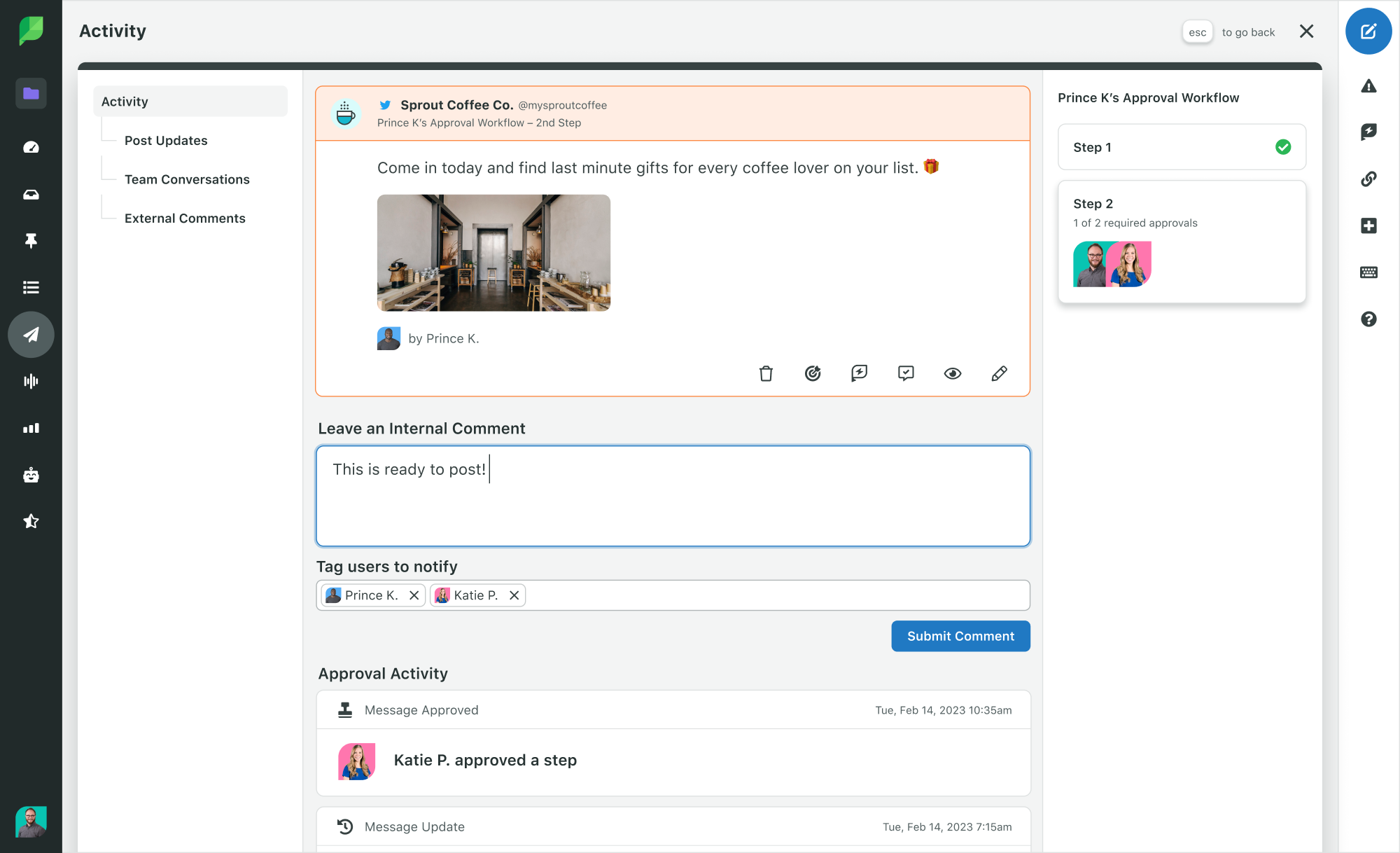
Follow up on your scheduled posts by establishing a process of responding and engaging with your audience. With Sprout, you can assign replies to different members of the team, which ensures that your followers always get a timely response when they tag you or comment on a post. Sprout’s Asset Library can also be used to create Auto-Responses and Saved Replies to frequently asked questions on social media. If your company handles support through a separate social media team your marketing team can always control the messaging, no matter who is posting.
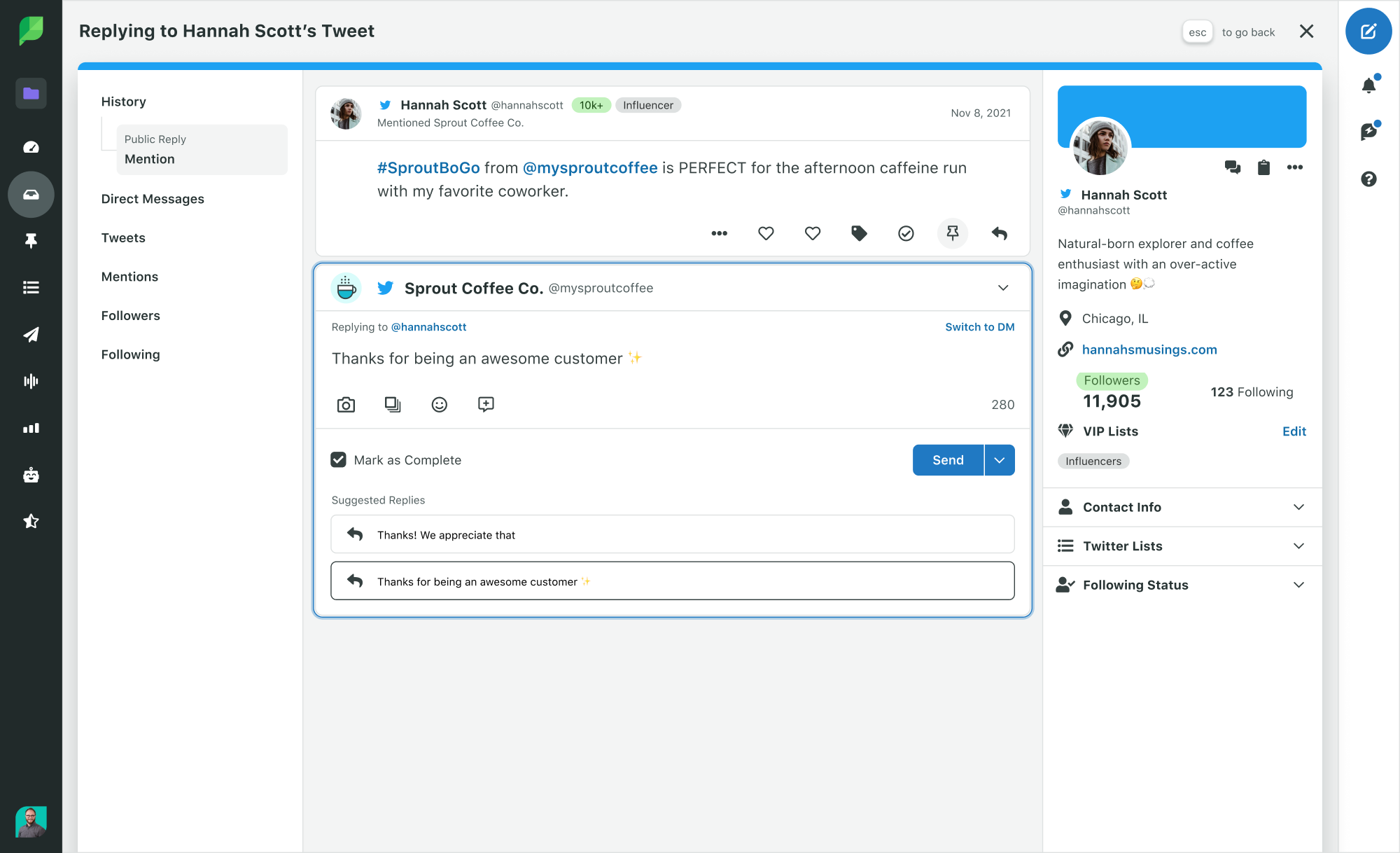
Including other teams aside from the marketing team when planning your social media content calendar will also help give you more ideas for things to post. Developers can look at your calendar and let you know when certain features will be launching and how to schedule for those launches accordingly. Human resources can remind you of important dates and company milestones worth posting about.
As a marketer, your time is too valuable to spend deciding what to post on every single day. A well-planned out social media content calendar lets you use your time to plan for the future and focus on other aspects of your marketing strategy. Take your content planning to the next level with our free tool to find the right content mix for your brand.
Recommended for you
View all Recommended for you- Categories
50 content creator tools you need to know about
Published on August 9, 2022 Reading time 13 minutes - Categories
The public apology: 9 ways to say we’re sorry (sincerely) from the brand account
Published on August 3, 2022 Reading time 11 minutes - Categories
Content creators: Who they are, what they do and how they partner with brands
Published on July 26, 2022 Reading time 14 minutes - Categories
What is hashtagging and how to use it effectively
Published on July 19, 2022 Reading time 10 minutes
